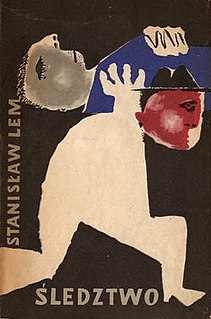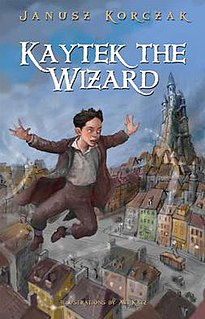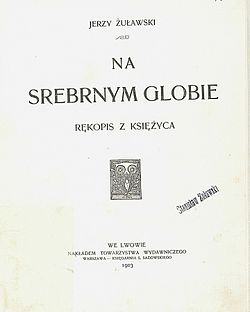 W
WAshes and Diamonds is a 1948 novel by the Polish writer Jerzy Andrzejewski. It was adapted into a film by the same title in 1958 by the Polish film director Andrzej Wajda. English translation, entitled Ashes and Diamonds, appeared in 1962. The story takes place during the last few days of World War II in Europe, and describes the political and moral dilemmas associated with the soon to be suppressed Anti-communist resistance in Poland (1944–1946). The protagonist Maciek is a soldier in the underground anti-communist Polish army assigned to kill the Communist Szczuka. The story follows Maciek's and other characters' actions in those ominous days.
 W
WBeing There is a satirical novel by the Polish-born writer Jerzy Kosinski, published in 1970. Set in America, the story concerns Chance, a simple gardener who unwittingly becomes a much sought-after political pundit and commentator on the vagaries of the modern world.
 W
WThe Career of Nicodemus Dyzma is a 1932 Polish bestselling political novel by Tadeusz Dołęga-Mostowicz. It was his first major literary success, with immediate material rewards, prompting Mostowicz to write and publish roughly two books per year. The book, very popular already in the interwar period, was made into a 1956 Polish film with Adolf Dymsza in the title role, then into a 1980 television miniseries starring Roman Wilhelmi, and into a 2002 comedy film starring Cezary Pazura.
 W
WComing out of the Shadow is a science fiction novel by Polish writer Janusz A. Zajdel. Critics variously translated the title as Out of the Shadow, Leaving the Shadow, etc.
 W
WKarol Maciej Szymanowski was a Polish composer and pianist, the most celebrated Polish composer of the early 20th century. He is considered a member of the late 19th-/early 20th-century modernist movement Young Poland and widely viewed as one of the greatest Polish composers.
 W
WIn Desert and Wilderness is a popular young adult novel by Polish author and Nobel Prize-winning novelist Henryk Sienkiewicz, written in 1911. It is the author's only novel written for children/teenagers. In Desert and Wilderness tells the story of two young friends, Staś Tarkowski and Nel Rawlison, kidnapped by rebels during Mahdi's rebellion in Sudan. It was adapted for film twice, in 1973 and in 2001.
 W
WInsatiability is a speculative fiction novel by the Polish writer, dramatist, philosopher, painter and photographer, Stanisław Ignacy Witkiewicz (Witkacy). Nienasycenie was written in 1927 and first published in 1930. It is his third novel, considered by many to be his best. It consists of two parts: Przebudzenie (Awakening) and Obłęd.
 W
WThe Investigation is a science fiction/detective/thriller novel by the Polish writer Stanisław Lem. The novel incorporates a philosophical discourse on explanation of unknown phenomena. It was first published in 1958 in Przekrój magazine and in 1959 as a book by the Publishing House of the Ministry of National Defense.
 W
WJeżycjada is a series of books for young people by Polish author Małgorzata Musierowicz. Its name derives from the Poznań district Jeżyce. Professor Zbigniew Raszewski, an admirer of the series and a friend of the author, invented this title jokingly referring to the Iliad. The first part of the cycle was published in 1977, and the newest is from 2018. A continuation of the cycle is planned. The books are very popular among Poles, both children and young people alike.
 W
WKaytek the Wizard is a 1933 children's novel by Polish author, physician, and child pedagogue Janusz Korczak. It was published in English translation in August 2012, the second of Korczak's novels to be published in English. His other novel to be published in English was King Matt the First. In addition, several of his pedagogical works have also been translated.
 W
WKing Matt the First is a children's novel by Polish author, physician, and child pedagogue Janusz Korczak. In addition to telling the story of a young king's adventures, it describes many social reforms, particularly targeting children, some of which Korczak enacted in his own orphanage, and is a thinly veiled allegory of contemporary and historical events in Poland. The book has been described as being as popular in Poland as Peter Pan was in the English-speaking world. It was the first of Korczak's novels to be translated into English – several of his pedagogical works have been translated, and more recently his novel Kaytek the Wizard was also published in English.
 W
WLimes inferior is a social science fiction dystopian novel written in 1982 by the Polish author Janusz A. Zajdel. Limes inferior, one of Zajdel's best-known works, is a dystopia showing a grim vision of a future society resulting from a merger of the two systems competing at the time - communism and capitalism. It is a seemingly free society, which is in fact tightly controlled through a system of electronic biometric ID cards (Keys), censored media and other forms of social control.
 W
WTrylogia Księżycowa is a trilogy of science fiction novels by the Polish writer Jerzy Żuławski, written between 1901 and 1911. It has been translated into Russian, Czech, German and Hungarian, and has been reprinted several times in Poland. They are his best-known works.
 W
WMiranda is a novel written by Antoni Lange in 1924. It was the last great work of Lange before he died, and his most famous book today. It is said that Miranda is an "occultic fiction" and a "romance ranked to a philosophical treaty". The novel is also known as "novelty writing" which conciliates dystopia and utopia. It is a matter of opinion to classify the novel to modernism or interwar period.
 W
WOrinoko is a Polish adventure novel by Arkady Fiedler, first published in 1957. Set in the eighteenth century in Spanish Venezuela, the book is addressed primarily to the teenage reader, following the adventures of the protagonist John Bober along the Orinoco.
 W
WThe Painted Bird is a 1965 novel by Jerzy Kosiński that describes World War II as seen by a boy, considered a "Gypsy or Jewish stray," wandering about small villages scattered around an unspecified country in Central and Eastern Europe. The story was originally described by Kosiński as autobiographical, but upon its publication by Houghton Mifflin he announced that it was a purely fictional account.
 W
WParadyzja is a 1984 science fiction novel by Polish writer Janusz A. Zajdel.
 W
WThe Peasants is a novel written by Nobel Prize-winning Polish author Władysław Reymont in four parts between 1904 and 1909. He started writing it in 1897, but because of a railway accident and health problems, it took seven years to complete. The first parts of the story were published in the newspaper Tygodnik Ilustrowany.
 W
WPrimeval and Other Times is a fragmentary novel by Olga Tokarczuk, published by Wydawnictwo W.A.B. in 1996.
 W
WRobinson Crusoe Island is a historical adventure novel for young people by Polish author Arkady Fiedler. It was first published in 1954.
 W
WSanatorium Under the Sign of the Hourglass is the English title of Sanatorium Pod Klepsydrą, a novel by the Polish writer and painter Bruno Schulz, published in 1937.
 W
WTime of Contempt is the second novel in the Witcher Saga written by Polish fantasy writer Andrzej Sapkowski, first published 1995 in Polish, and 2013 in English. It is a sequel to the first Witcher novel Blood of Elves and is followed by Baptism of Fire.
 W
WTrans-Atlantyk is a novel by the Polish author Witold Gombrowicz, originally published in 1953. The semi-autobiographical plot of the novel closely tracks Gombrowicz's own experience in the years during and just after the outbreak of World War II.
 W
WVan Troff's Cylinder is a social science fiction novel by Polish writer Janusz A. Zajdel. The novel covers the problems of time travel, society development, eugenics and isolated societies. At the time of its release it was treated as a warning for totalitarian systems.
 W
WXavras Wyżryn is an alternate history novel by Polish science fiction writer Jacek Dukaj, published in 1997. It is considered as one of the best Polish alternate history novels, discussing Polish martyrology, circling around the philosophical aspects of war, showing the thin line between terrorism and fighting for freedom, and "packing lots of action", making it also part of a military science fiction genre.